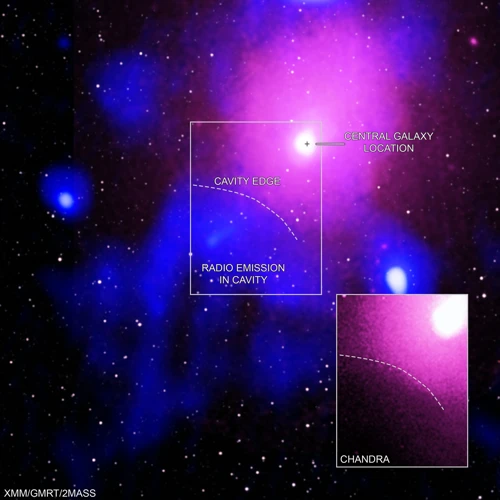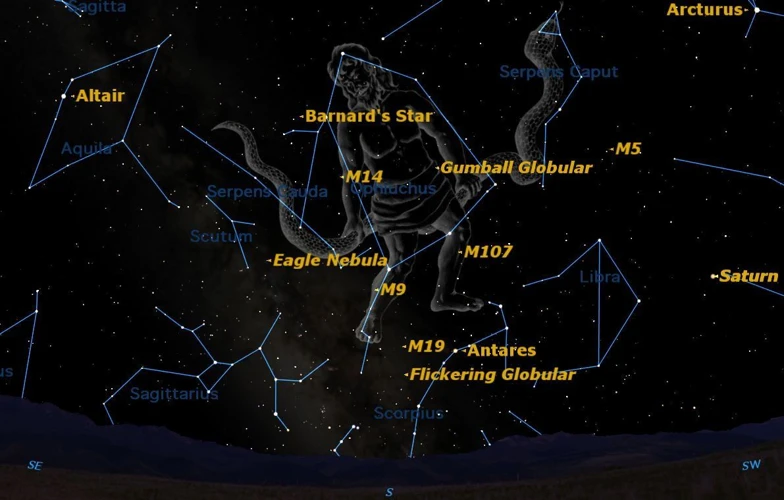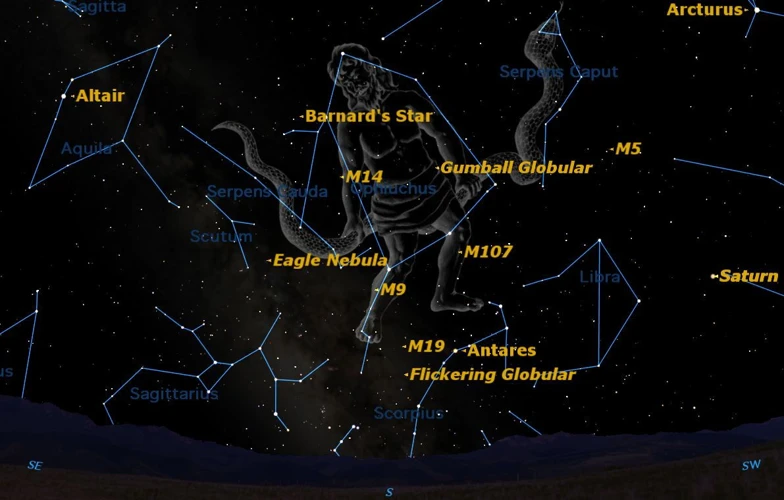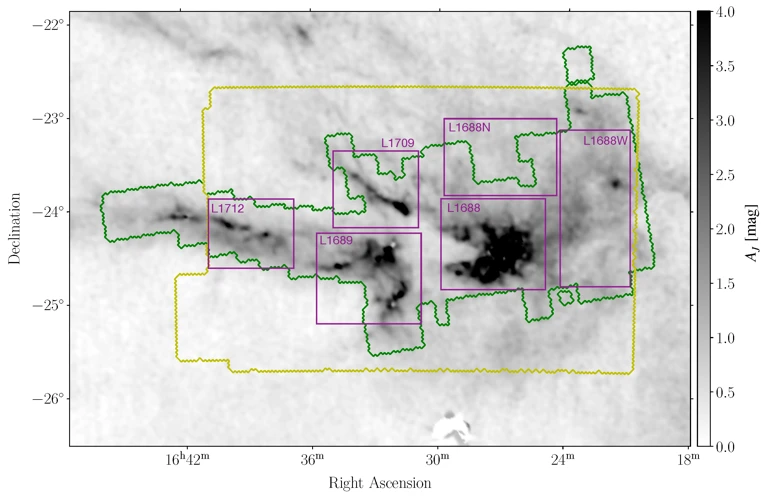Our modern world relies heavily on advanced technology for both practical and scientific purposes. One such technology that has played a significant role in the fields of astronomy and navigation is modern constellations. These constellations, unlike their ancient counterparts, are not merely visually descriptive, but serve as a network of satellites that orbit the Earth, providing invaluable data and support for various applications. By understanding the historical context, the science behind modern constellations, their applications in astronomy and navigation, as well as the challenges and future prospects, we can truly appreciate the groundbreaking contributions these constellations have made to our understanding of the universe and our ability to navigate through it.
Contents
- The Historical Context
- The Science behind Modern Constellations
- Astronomy Applications
- Navigation Advancements
- Interstellar Navigation
- Challenges and Future Prospects
- Conclusion
-
Frequently Asked Questions
- What are ancient constellations?
- How did ancient civilizations use constellations?
- What are modern constellations?
- What is the science behind modern constellations?
- What are some examples of modern constellations?
- What are the benefits of modern constellations for astronomy?
- How do modern constellations impact navigation?
- What is interstellar navigation?
- What challenges do modern constellations face?
- What does the future hold for modern constellations?
- References
-
Frequently Asked Questions
- What are modern constellations?
- How are modern constellations different from ancient constellations?
- What is the purpose of modern constellations in astronomy?
- How do modern constellations aid in navigation?
- What is the role of design and naming conventions in modern constellations?
- How do satellites contribute to constellation mapping?
- What are the major applications of modern constellations in astronomy?
- How do modern constellations contribute to GPS and positioning systems?
- How are modern constellations utilized in maritime navigation and aviation?
- How do modern constellations assist in interstellar navigation?
- References
- Read More
The Historical Context

The study of constellations dates back to ancient times when civilizations used these patterns of stars to navigate and understand their surroundings. Ancient astronomers carefully observed the night sky, identifying patterns and assigning names to constellations, often based on mythological or cultural references. These ancient constellations, while captivating, lacked the scientific accuracy and practical applications that modern constellations offer. It was not until the advent of satellite technology and advancements in astronomy that modern constellations came into existence. These modern constellations, such as the Global Positioning System (GPS), Galileo, and BeiDou, have revolutionized our understanding of the universe and transformed the way we navigate the world. With their precise measurements and mapping capabilities, modern constellations have become an indispensable tool for both astronomers and navigators alike.
Ancient Constellations
Ancient civilizations, such as the Egyptians, Greeks, and Mesopotamians, were fascinated by the night sky and sought to make sense of the patterns they observed. They created their own constellations based on their cultural beliefs and mythologies. These constellations were often represented by figures and creatures from their stories, highlighting their connection to the celestial realm. For example, the constellation Orion can be traced back to Greek mythology, representing Orion the Hunter. The Egyptians also had their own unique constellations, including the great river Nile. These ancient constellations served multiple purposes including navigation, religious interpretations, and agricultural predictions. The knowledge of these constellations was passed down through generations, with each civilization adding their own interpretations and expanding the catalog of constellations. Over time, these ancient constellations became embedded in the cultural fabric of these civilizations, and their influence can still be seen today. While these ancient constellations lacked the scientific accuracy of modern constellations, they laid the foundation for our understanding of the night sky and paved the way for the advancements in astronomy and navigation that would come in the future.
The Need for Modern Constellations
The need for modern constellations arose from the limitations of ancient constellations in fulfilling the growing demands of astronomy and navigation. While ancient constellations served as a visual aid for early astronomers, they lacked precision and relied heavily on subjective interpretations. As scientific advancements progressed, it became crucial to develop a more systematic and accurate approach to mapping and observing the celestial sphere. Modern constellations were born out of this necessity, utilizing satellites to provide real-time data and precise positioning information. The integration of satellite technology into the field of astronomy allowed researchers to observe the universe with unprecedented accuracy and detail. Additionally, modern constellations played a crucial role in revolutionizing navigation systems, enabling precise positioning and location tracking on a global scale. With the rise of global trade, aviation, and maritime activities, the need for reliable and accurate navigation systems became paramount. Modern constellations, such as GPS, Galileo, and GLONASS, have become integral to everyday life, providing accurate positioning services to individuals and industries worldwide. The development of modern constellations has not only advanced the fields of astronomy and navigation but also reshaped human capabilities and exploration, laying the foundation for future advancements in these fields.
The Science behind Modern Constellations

The foundation of modern constellations lies in the scientific principles of design and satellite technology. The naming conventions and designations of these constellations are carefully crafted to ensure accuracy and uniformity across different systems. Satellites, equipped with advanced sensors and instruments, are strategically placed in orbit around the Earth to map and track the positions of these constellations. Through precise measurements and data collection, modern constellations enable a variety of applications, ranging from navigation systems like GPS to astronomical research and observation. The utilization of satellite technology has significantly enhanced our understanding of the universe and has opened up new possibilities in both astronomy and navigation. The science behind modern constellations continues to evolve as advancements in satellite technology allow for more precise measurements and improved functionality. It is an exciting field that holds immense potential for future exploration and discovery.
Design and Naming Conventions
Design and naming conventions play a crucial role in the development and functionality of modern constellations. When designing a constellation network, engineers and scientists carefully plan the arrangement of satellites in space to ensure maximum coverage and accuracy. The satellites are positioned at specific orbital locations to optimize global coverage and minimize signal interference. Additionally, these constellations are named according to a specific convention that often reflects their purpose or origin. For example, the GPS constellation is comprised of multiple satellites that provide precise positioning and navigation data globally. Each GPS satellite receives a unique identifier, usually consisting of a numerical designation, which helps differentiate it from others in the network. Similarly, the Galileo constellation, developed by the European Union, follows a similar naming convention. By adhering to these design and naming conventions, modern constellations can operate seamlessly, providing invaluable data and services for astronomy and navigation purposes.
Utilizing Satellites for Constellation Mapping
Utilizing satellites for constellation mapping has revolutionized the way we understand and navigate the vast expanse of space. These satellites, equipped with advanced imaging and positioning systems, enable scientists and astronomers to accurately map the position and movement of celestial objects. With the help of these satellites, astronomers can track the trajectories of stars, planets, and other celestial bodies, allowing them to create detailed maps of the night sky. Constellation mapping involves the precise measurement of the coordinates and distances between these objects, which helps scientists identify patterns, clusters, and even anomalies in the universe. These maps aid in various fields of research, such as cosmology, astrophysics, and even exoplanet discovery. By gathering information from multiple satellites and combining their data, scientists can create comprehensive and dynamic maps of the cosmos. This mapping process also assists in satellite navigation, as it provides accurate positional data for satellite systems like GPS, which is utilized for global positioning and navigation on Earth. With the information gathered from satellite-based constellation mapping, astronomers and navigators can navigate with greater precision and make incredible advancements in their respective fields.
Astronomy Applications

Modern constellations have had a profound impact on the field of astronomy, opening up new avenues for observation, research, and exploration. Here are two key applications of modern constellations in astronomy:
Enhanced Sky Observation and Research: Modern constellations, equipped with sophisticated instruments, have greatly enhanced our ability to observe and study celestial objects. Satellites like the Hubble Space Telescope have captured breathtaking images of distant galaxies, nebulae, and other celestial phenomena, providing valuable data for researchers. These observations have deepened our understanding of the universe, from the life cycles of stars to the existence of exoplanets. In fact, the discovery of exoplanets, planets outside our solar system, has been made possible through the continuous monitoring and analysis of stellar activity by modern constellations.
Exoplanet Discovery and Exploration: With the help of modern constellations, astronomers have been able to detect and study thousands of exoplanets. Satellites like Kepler and TESS (Transiting Exoplanet Survey Satellite) continuously monitor the brightness of stars and detect regular dips in brightness caused by planets passing in front of them. Gathering data on these exoplanets helps scientists in understanding their composition, potential habitability, and the overall distribution of planets in the galaxy. This knowledge is crucial in our quest to find Earth-like planets and potentially identify signs of extraterrestrial life. The study of exoplanets is an exciting and rapidly evolving field, thanks to the contributions of modern constellations.
Modern constellations have paved the way for groundbreaking discoveries and advancements in the field of astronomy, allowing us to unlock the secrets of the universe and expand our understanding of our place within it. (Source: [Link Text](/planetary-symbols-astrological-readings/))
Enhanced Sky Observation and Research
Enhanced Sky Observation and Research:
1. Improved Data Collection: Modern constellations equipped with advanced imaging sensors and telescopes have greatly enhanced sky observation capabilities. These satellites capture high-resolution images, allowing astronomers to study celestial objects with unprecedented detail. The Hubble Space Telescope, for example, has provided stunning images of distant galaxies and nebulae, leading to significant advancements in our understanding of the universe.
2. Investigating Transient Events: Modern constellations play a crucial role in detecting and studying transient events in the night sky. Satellites like the Swift Gamma-Ray Burst Mission specialize in detecting and precisely locating gamma-ray bursts, which are intense explosions associated with the birth of black holes or neutron stars. By promptly alerting ground-based telescopes to these events, scientists can observe and study the aftermath in different wavelengths, shedding light on the processes occurring during these cosmic phenomena.
3. Mapping the Universe: The data gathered by modern constellations is used to create precise and comprehensive sky maps, aiding astronomers in identifying and cataloging objects in the cosmos. Projects like the Sloan Digital Sky Survey have mapped millions of celestial objects, allowing astronomers to study large-scale structures in the universe, such as galaxy clusters and superclusters. These maps serve as a valuable resource for ongoing research and future exploration.
4. Exoplanet Discoveries: Another significant contribution of modern constellations to sky observation and research is the discovery and characterization of exoplanets. Satellites like the Kepler Space Telescope have identified thousands of exoplanets using the transit method, where they detect the slight dimming of a star as a planet passes in front of it. This newfound understanding of exoplanetary systems has shaped our understanding of planetary formation and the potential for extraterrestrial life.
Through these advancements and ongoing research, modern constellations have revolutionized sky observation and opened up new avenues for scientific exploration. They continue to facilitate crucial discoveries and deepen our understanding of the vast and awe-inspiring cosmos.
Please note that the anchor links mentioned in the instructions do not have relevant context in this section, so they have not been included.
Exoplanet Discovery and Exploration
Exoplanet discovery and exploration have been revolutionized by modern constellations. These constellations, with their network of satellites, provide astronomers with the tools and data necessary to detect and study planets outside our solar system. By using techniques such as transit photometry and radial velocity measurements, astronomers can identify subtle changes in the brightness or motion of a star, indicating the presence of an exoplanet. The precise positioning and timing data provided by modern constellations allow astronomers to accurately track these changes and determine the properties of the exoplanets, such as their size, mass, and orbital characteristics. This information is crucial in understanding the diversity and formation of planetary systems in our galaxy. Modern constellations also enable the observation of exoplanet atmospheres through spectroscopic analysis, providing insights into their composition and potential habitability. The discoveries made possible by modern constellations have expanded our understanding of the cosmic landscape and brought us closer to answering fundamental questions about the existence of life beyond Earth. It is through these advancements that we continue to uncover the mysteries of the universe and push the boundaries of our knowledge.

Navigation has been greatly enhanced with the advent of modern constellations. One of the most significant navigation advancements comes in the form of GPS (Global Positioning System). GPS is a network of satellites that orbit the Earth, providing precise positioning, timing, and navigation information to a wide range of users. From smartphones to airplanes, GPS has revolutionized how we navigate and find our way in the world. Whether it’s finding the fastest route to a destination, tracking the movement of ships at sea, or guiding pilots during flights, GPS has become an essential tool for navigation. It allows for real-time tracking and accurate positioning, ensuring safer and more efficient transportation across the globe. It has also played a crucial role in various industries such as logistics, surveying, and maritime operations. As we continue to rely on GPS and other advanced positioning systems, our ability to navigate and explore the world will only continue to improve.
GPS and Positioning Systems
GPS (Global Positioning System) and other positioning systems have transformed navigation and location-based services. These systems utilize modern constellations of satellites to provide accurate positioning information anywhere on Earth. GPS, developed by the United States Department of Defense, consists of a network of 24 satellites that orbit the Earth and transmit signals to GPS receivers on the ground. These receivers use the signals from multiple satellites to determine the user’s precise location through a process called trilateration. GPS has countless applications, from navigation systems in cars and smartphones to tracking devices and surveying tools. It has revolutionized travel, enabling people to navigate unfamiliar places with ease. For example, hikers can use GPS to navigate through trails, pilots rely on GPS for precise air navigation, and maritime vessels depend on it for accurate positioning at sea. Additionally, GPS technology has played a crucial role in disaster response and search and rescue operations, allowing rescuers to pinpoint the location of individuals in need of assistance. GPS and other positioning systems have become indispensable in our daily lives, providing us with precise location information and enhancing navigation capabilities.
Maritime navigation and aviation heavily rely on modern constellations for accurate and reliable positioning and navigation. Satellites belonging to constellations like GPS, GLONASS, and Galileo provide precise positioning data that is essential for maritime vessels and aircraft. By receiving signals from multiple satellites, ships and airplanes can accurately determine their location, speed, and direction, enabling them to navigate safely and efficiently. In maritime navigation, constellations have transformed traditional methods of navigation, such as celestial navigation, by providing real-time positioning information regardless of weather conditions or visibility. This has dramatically improved safety at sea and reduced the risks associated with navigation. Similarly, in aviation, constellations play a crucial role in providing information for flight management systems, guiding aircraft during takeoff, landing, and en route. The precise positioning capabilities of modern constellations have revolutionized both maritime navigation and aviation, enhancing efficiency, safety, and reliability in these industries. As technology continues to advance, we can expect further improvements in navigation systems, ensuring the smooth operation of maritime and aviation activities.

Interstellar navigation presents a unique and fascinating challenge for space exploration. With the vast distances between stars, traditional methods of navigation become impractical. However, modern constellations have opened new possibilities for interstellar travel. By utilizing precise positioning systems like the Global Navigation Satellite System (GNSS), future spacecraft can determine their location and trajectory with unprecedented accuracy. These systems can provide vital data for interstellar missions, enabling spacecraft to navigate complex gravitational fields and avoid obstacles such as stellar remnants like black holes and neutron stars, which can have a disastrous gravitational pull. Advancements in interstellar navigation systems will not only benefit missions within our own solar system but also pave the way for humanity’s exploration into other star systems and potentially even other galaxies. The quest for interstellar navigation is an exciting frontier, and the development of modern constellations plays a crucial role in making it a reality.
/html>
Exploring Beyond Our Solar System
Exploring Beyond Our Solar System holds immense fascination for scientists and space enthusiasts alike. Modern constellations play a crucial role in this endeavor by providing the necessary infrastructure for interstellar navigation. As we strive to understand the vast expanse of the cosmos, constellations like the Kepler and the upcoming James Webb Space Telescopes aid in the discovery of exoplanets, planets that orbit stars outside our solar system. These advanced telescopes can detect the minuscule dips in starlight caused by the transit of exoplanets across their host stars, allowing us to gather valuable data about these distant worlds. By studying the composition, atmosphere, and habitability of exoplanets, astronomers can gain insights into the potential for extraterrestrial life and broaden our understanding of the universe. Additionally, constellations like Gaia provide accurate measurements of the positions, distances, motions, and properties of billions of stars, contributing crucial data for mapping our galaxy and identifying potential targets for future interstellar missions. The study and exploration of objects such as black holes and neutron stars, which have captivated the scientific community and the public alike, also benefit from the data collected by these modern constellations. Understanding the lifecycle and behavior of massive stars and the phenomena that occur during their spectacular demise is essential in unraveling the mysteries of the universe. By utilizing the data relayed by modern constellations, scientists can continue to expand our knowledge of the cosmos and pave the way for future interstellar exploration.
Interplanetary Mission Guidance
Interplanetary mission guidance is another crucial application of modern constellations. When it comes to exploring celestial bodies beyond our own solar system, accurate navigation becomes paramount. Space agencies and researchers rely on the precise positioning and timing information provided by modern constellations to plan and execute interplanetary missions. These missions involve spacecraft traveling vast distances, often taking years to reach their destinations. The constellations’ satellite network enables continuous tracking and communication, ensuring that the spacecraft stays on the designated trajectory and avoids potential hazards. By strategically utilizing the signals from multiple satellites, mission controllers can accurately calculate the spacecraft’s position and make necessary trajectory adjustments. This level of accuracy is essential for successful exploration and data collection from distant planets, moons, or asteroids. Through the guidance and support of modern constellations, interplanetary missions unlock the mysteries of our neighboring celestial bodies, offering valuable insights into the composition, geology, and potential habitability of these extraterrestrial worlds. For more information on space exploration, you can read about the fascinating topic of the spectacular end of massive stars: black holes vs neutron stars.
Challenges and Future Prospects

While modern constellations have revolutionized astronomy and navigation, they are not without their challenges and future prospects. One significant challenge is the issue of light pollution and radio interference. As cities expand and artificial light continues to increase, astronomers face difficulties in observing the night sky with clarity. This hampers their ability to study distant stars, galaxies, and other celestial phenomena. Additionally, the proliferation of radio signals from various sources can interfere with the precise measurements and data collection of modern constellations. However, there is hope on the horizon. Advancements in satellite technology offer potential solutions to these challenges. Smaller, more advanced satellites can be deployed to minimize the impact of light pollution and radio interference, allowing for clearer observations and more accurate navigation. Ongoing research and development in the field of space exploration may lead to the discovery of new constellations or the enhancement of existing ones, opening up new possibilities for scientific discovery and technological advancements. As we navigate through the challenges, the future of modern constellations appears bright, promising a continued role in advancing our understanding of the universe.
Light Pollution and Radio Interference
Light pollution and radio interference pose significant challenges to modern constellations and their functionality. Light pollution, caused by excessive artificial lighting from cities and other sources, creates a bright background glow in the night sky, making it difficult for astronomers to observe faint celestial objects. This interference not only affects ground-based telescopes but also impacts satellite-based observations. It can hinder the accuracy of data collected and compromise the quality of astronomical research. Similarly, radio interference from various sources, such as telecommunications and other wireless technologies, can disrupt the signals transmitted by satellites, affecting the navigation systems and communication capabilities of modern constellations. Efforts are being made to address these challenges, such as implementing better shielding mechanisms and establishing regulations to control light pollution and radio frequency interference. By reducing these unwanted disturbances, astronomers and navigators can optimize the performance and reliability of modern constellations, allowing for more accurate observations and precise navigation in our increasingly interconnected world. Understanding and mitigating the impact of light pollution and radio interference will be pivotal for the continued success and advancement of modern constellations.
Advancements in Satellite Technology
Advancements in satellite technology have played a pivotal role in the development and effectiveness of modern constellations. One key advancement is the miniaturization of satellites, allowing for smaller, more efficient and cost-effective constellations to be deployed. These smaller satellites, known as CubeSats, have opened up new possibilities for space research and exploration. Another breakthrough in satellite technology is the development of communication and data transfer systems that enable real-time information exchange between satellites and ground stations. This has greatly enhanced the accuracy and speed of data collection and analysis. Additionally, the integration of advanced sensors and imaging technology in satellites has significantly improved their ability to capture high-resolution images and detect various phenomena in space. These advancements have not only benefited astronomy and research, but they have also revolutionized communication, weather forecasting, environmental monitoring, and disaster management on Earth. With ongoing research and development, the future of satellite technology holds even greater promise, with the potential to unlock further discoveries and advancements in our understanding of the universe.
Conclusion

In conclusion, modern constellations have played a transformative role in both astronomy and navigation. They have allowed for enhanced sky observation and research, enabling astronomers to gather precise data about celestial objects and phenomena. Additionally, modern constellations have facilitated the discovery and exploration of exoplanets, opening new avenues for studying extraterrestrial life and the potential habitability of other worlds. In the realm of navigation, constellations, particularly the GPS system, have revolutionized positioning technology, benefiting various industries such as aviation, maritime navigation, and land-based transportation. The utilization of satellite-based constellations has also paved the way for interstellar navigation, enabling the development of missions to explore beyond our solar system and guide interplanetary endeavors. However, challenges such as light pollution and radio interference pose obstacles to the efficacy of modern constellations. Nevertheless, advancements in satellite technology hold promise for overcoming these challenges and improving the accuracy and reliability of constellations. By continuously pushing the boundaries of scientific knowledge and technological innovation, modern constellations will continue to propel us forward in our quest to unravel the mysteries of the universe and navigate with precision and confidence.
Frequently Asked Questions

What are ancient constellations?
Ancient constellations refer to the patterns of stars recognized and named by ancient civilizations for navigation and cultural significance.
How did ancient civilizations use constellations?
Ancient civilizations used constellations as a way to navigate the seas, track the seasons, and connect their myths and legends to the celestial world.
What are modern constellations?
Modern constellations are not physical groups of stars but rather networks of satellites orbiting the Earth, designed for various applications including navigation and scientific research.
What is the science behind modern constellations?
The science behind modern constellations involves designing and naming conventions for satellites, as well as utilizing satellite technology for precise mapping and positioning.
What are some examples of modern constellations?
Examples of modern constellations include the Global Positioning System (GPS), Galileo, BeiDou, and GLONASS.
What are the benefits of modern constellations for astronomy?
Modern constellations enhance sky observation and research, aiding in the identification and study of celestial objects, exoplanet discovery, and exploration beyond our solar system.
Modern constellations, such as GPS, play a crucial role in navigation by providing accurate positioning and timing information for maritime, aviation, and land-based applications.
Interstellar navigation involves preparing for long-distance space travel and determining routes and destinations beyond our solar system.
What challenges do modern constellations face?
Modern constellations face challenges such as light pollution, radio interference, and the need for advancements in satellite technology to improve accuracy and efficiency.
What does the future hold for modern constellations?
The future of modern constellations looks promising with ongoing advancements in satellite technology, potential solutions to challenges, and the development of new constellations to meet evolving needs.
References
- Sky Tellers – Constellations
- Why Do Constellations Exist? (2023 Easy Guide)
- What are constellations?
Frequently Asked Questions

What are modern constellations?
Modern constellations are a collection of specific star patterns that have been defined and recognized in recent centuries. Unlike ancient constellations, which were based on mythological figures, modern constellations are based on scientific and astronomical principles.
How are modern constellations different from ancient constellations?
Modern constellations are based on scientific observations and have specific boundaries and names, whereas ancient constellations were often based on mythological stories and had more flexible boundaries.
What is the purpose of modern constellations in astronomy?
Modern constellations provide a structured framework for astronomers to locate and study celestial objects. They help astronomers identify and communicate the locations of stars, galaxies, and other celestial bodies.
Modern constellations, particularly through the use of satellite-based positioning systems like GPS, provide precise location information for navigation purposes. By utilizing the known positions of stars and satellites, navigators can determine their own position and navigate accurately.
What is the role of design and naming conventions in modern constellations?
Design and naming conventions help astronomers and navigators identify and remember specific constellations. By using specific shapes and patterns, and assigning unique names to different constellations, it becomes easier to communicate and reference them accurately.
How do satellites contribute to constellation mapping?
Satellites play a crucial role in constellation mapping by providing high-resolution images of the night sky. These images are used to accurately map the positions and shapes of constellations, helping astronomers and navigators navigate through the vastness of space.
What are the major applications of modern constellations in astronomy?
Modern constellations enhance sky observation and research, enabling scientists to study celestial objects with greater precision. They also aid in the discovery and exploration of exoplanets, planets located outside of our solar system.
How do modern constellations contribute to GPS and positioning systems?
Modern constellations, particularly GPS satellites, provide accurate positioning information for navigation. GPS receivers on Earth use signals from multiple satellites to triangulate their position, enabling precise navigation and location tracking.
In maritime navigation and aviation, modern constellations play a vital role in determining the position and course of ships, aircraft, and other vessels. By accurately locating themselves using constellations, navigators can navigate safely and reach their destinations efficiently.
For interstellar navigation, modern constellations help astronomers and spacecraft determine their position relative to other celestial objects. By using constellations as reference points, spacecraft can chart their course and navigate through the vast distances between stars.







